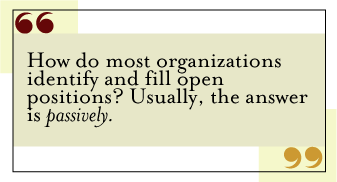Selecting and developing future managers is a crucial task -- and a big concern for many companies, particularly for leadership roles. In a study by the Corporate Leadership Council, 72% of companies predict they'll have an increasing number of leadership vacancies over the next three to five years. At the same time, 76% are "less than confident" in their abilities to adequately staff these positions.
To make matters worse, corporate boards often make radical decisions when they feel their CEO is underperforming. One study found that chief executives appointed after 1985 are three times more likely to be fired than CEOs who were appointed before that date.
 |
All companies need to find and develop the next generation of leaders if they want to survive, let alone thrive. But most experts agree that only a few companies master succession management. The first article in this two-part series will discuss the practices that set those companies apart. The second part will offer a series of practical guidelines for successfully managing the succession process.
Requirements for success
Companies that create an effective succession management process:
- quickly anticipate and fill succession gaps
- identify employees with high management potential and actively plan their careers and development to build "bench strength"
- align their "people strategy" with their "business strategy." As a company grows and its strategy evolves, its leadership needs can change significantly. To meet needs like these, companies must regularly discuss their talent recruitment and development practices.
When organizations meet these requirements, they create the kind of leadership and management capacity that delivers sustainable business results. They also reduce the range in performance in key roles, minimize attrition among top performers, and promote a high internal hiring rate.
Many senior managers think their company is adept at succession planning, and they may be right. The problem is that although succession planning is essential, it's just the first step. It's equally important to develop the leaders and managers so they can execute the business strategy and deliver results. That's why companies that succeed at finding and nurturing leaders who can grow their business do more than plan: They excel at succession management.
Let's take a look at how the best organizations make the succession process an integral part of their culture and how they go about developing and nurturing tomorrow's leaders.
Making the succession process part of your company culture
How do most organizations identify and fill open positions? Usually, the answer is passively. A position opens up, a search begins, and someone is found to fill it.
Best-practice organizations, in contrast, are more systematic and proactive. These organizations:
- use an ongoing planning process. Best-practice organizations conduct periodic group discussions, often as part of a staffing review process. (See "Evaluating Employee Performance [Part 2]" in See Also.) In a staffing review, leadership teams from across business units meet quarterly or semi-annually to discuss their teams' performance and needs as well as strategies for developing high-potential managers. Conducting staffing reviews is a powerful performance management tool that can be a key driver of the succession management process.
- are inclusive. Rather than focusing on one or two candidates for a key role, best-practice organizations develop large pools of management and leadership talent. Broadening the talent pool increases a company's overall chances of success by improving its capabilities.
- In one such company, every employee is considered to have high potential and is eligible for management or leadership positions. This company fosters a culture that encourages coaching and that supports and rewards the individual growth and development of all employees.
- keep the process simple. Succession management can be made too complicated by elaborate forms and processes. When this happens, the process usually dominates the discussion rather than the talents, skills, and knowledge of the candidates.
- One company used to require its executives to bring written assessments of their employees to staffing reviews. Unfortunately, the executives became so committed to supporting their written opinions that it stifled open discussion. They solved the problem by eliminating some of the paperwork, which created a forum for open-minded conversation.
- In addition, world-class organizations open up the succession management process, making it as transparent to the organization as possible. This encourages clarity and integrity and minimizes politics.
- "own" their succession management. The human resources department should support the process, but management must own it. Accountability for selecting and developing managers and leaders cannot be delegated; it is integral to business success.
The most effective succession processes are disciplined, yet flexible, open, inclusive, and owned by management. Forms and processes are subordinated to dialogue. The goal is for leaders to gain insights into their employees' performance and potential. Businesses that successfully implement this kind of process make succession management an integral part of their corporate culture.
Best practices in management and leadership development
In too many organizations, management development is driven by rigid training curricula, guided by compulsory competency models and 360˚ assessments, and reinforced by standardized performance evaluation processes. Organizations that excel in succession management, however, approach the development of their managers and leaders quite differently. These organizations:
 |
- emphasize on-the-job development. Studies have shown that real development happens on the job, not in the classroom. The amount of information that managers retain and internalize from training sessions pales when compared to what they gain from real-life experience. Best-practice organizations develop their managers and leaders by intentionally offering them a diverse range of career-building learning experiences.
- In the past, many companies practiced job rotation -- moving employees through different functional responsibilities -- from finance to sales to human resources. This is often an ineffective, even dysfunctional, approach. Few employees have what it takes to excel in all those areas. Instead, smart companies create diverse experiences within a functional area. They might move a high-potential executive from a small business unit to a larger one, and eventually, to a global business unit. This builds executives' leadership strengths and offers them opportunities to learn how to overcome business challenges regardless of the business unit's size, complexity, country, culture, and marketplace.
- create progressive assignments. Great organizations identify high-potential managers, then move them through the company at a quick, yet careful, pace. Managers may progress through a series of challenging jobs rather quickly -- every 18-24 months -- and as soon as they've mastered one job, they move to the next challenge. But their career moves must be carefully paced; assignments that are too short can encourage managers to deal only with the problems that they already know how to fix.
- carefully design assignments. In most world-class organizations, roles and responsibilities are properly designed; managers understand what they're expected to learn and do, and they have clearly defined and quantified goals. In addition, their jobs are designed to give them significant "headroom" -- authority and responsibility -- and "elbow room" -- scope and variety. As William McKnight, the celebrated chairman of 3M, once said, "If you put fences around people, you get sheep. Give people the room they need."
- individualize development. Although certain experiences and approaches may be more effective than others, each person learns and develops differently. For example, some people love to learn from their peers, while others learn best through trial and error. Best-practice organizations personalize development through informal coaching, ongoing feedback, and mentoring -- at all levels. A multinational organization, for example, began a program in which the top 300 executives each identify a recent college graduate with the potential to become an executive. The executive then sponsors that employee and supports his or her career development.
- help managers make crucial connections. One study showed that 40% of all newly promoted managers and executives failed within the first 18 months of their promotion because they didn't build strong teams or reach out to their colleagues and peers. Similarly, the quality of a manager's working relationship with his or her superior is a critical success factor and has a substantial impact on the person's success. The emotional and relationship factors are important, and they have to be encouraged and developed.
Rather than relying on standardized training curricula, best-practice businesses develop their managers and leaders on the job through a series of challenging and diverse experiences. Their roles are broadly defined, yet expectations are clear, and they receive ongoing feedback and coaching to maximize the benefits from each learning experience.
These practices aren't easy to implement, and they require discipline and commitment to sustain. There are specific techniques and processes, however, that enable organizations to become world-class in succession management. The next article in this two-part series will show how your business can implement those practices.


